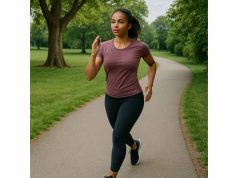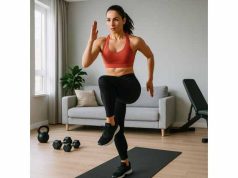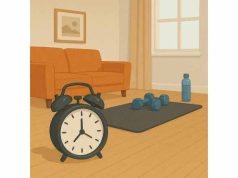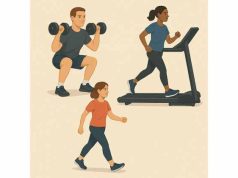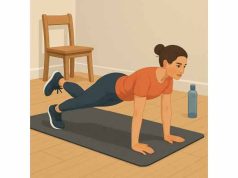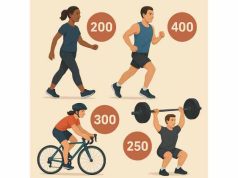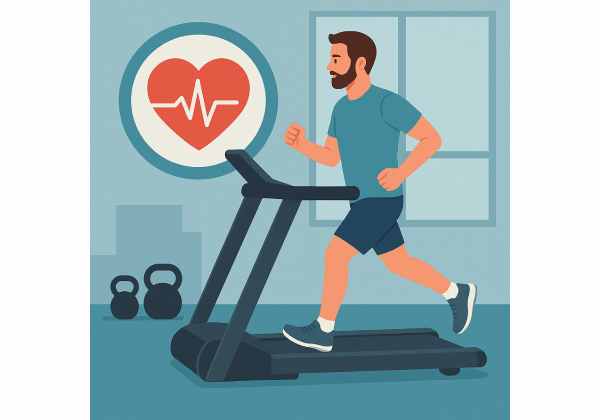
Zone 2 is that “conversational” pace where breathing stays steady and you could go a long time. It’s gentle enough to repeat most days, yet strong enough to upgrade your metabolism, heart, and mitochondria. For weight loss, that combination is gold: more weekly minutes, less soreness, and a plan you can live with. This guide shows you how to find your Zone 2 heart rate without a lab, why it’s so effective for fat loss, and how to program cycling, walking, rowing, and more into an eight-week plan. We’ll also cover technique, safety, tracking, and troubleshooting. For the bigger picture on blending strength, cardio, and steps, see our exercise framework for weight loss.
Table of Contents
- Why Zone 2 works for fat loss
- Find your Zone 2 heart rate
- Benefits you can measure
- Zone 2 workouts by modality
- Weekly plan and progression
- Technique, safety and adjustments
- Tracking, metrics and adherence
- Frequently Asked Questions
Why Zone 2 works for fat loss
Zone 2 sits just below the point where talking becomes choppy. In this “easy-to-moderate” band, fuel use leans toward fat, the cardiovascular system is heavily trained, and soreness is modest. That matters when you’re trying to lose weight because the driver of progress is total weekly minutes you can repeat—not occasional all-out sessions.
Consistency beats intensity.
Most people can maintain Zone 2 for 30–60+ minutes, three to five days per week. That consistency raises weekly energy expenditure without spiking hunger or joint irritation. Contrast that with high-intensity intervals: useful in small doses, but they often cut into tomorrow’s motivation or steps.
Metabolic upgrades with low stress.
Zone 2 improves mitochondrial function (your cells’ engines), capillary density, and the heart’s stroke volume. Translation: more energy output per heartbeat and better endurance at daily tasks. You’ll notice the same hill feels easier and your heart rate sits lower at a given pace after a few weeks.
The appetite and recovery advantage.
Because Zone 2 doesn’t bury you, sleep tends to improve and appetite stays more predictable. That makes it easier to keep a modest calorie deficit without white-knuckle cravings.
It plays well with strength training.
Strength preserves lean mass while the scale moves. Zone 2’s low joint stress means you can pair it with two short lifting sessions weekly without feeling wrecked.
A realistic role in a weight-loss plan
Think of Zone 2 as your base: 150–240+ minutes per week spread across 3–5 sessions. Add two brief strength workouts, maintain a daily steps habit, and sprinkle in a little higher intensity only when recovery is robust. New to training or returning after a layoff? Review safe rate-of-change guidance in our sustainable weight-loss basics, then start with the find-your-zone steps below.
Key takeaways
- Zone 2 = steady, conversational effort you can repeat often.
- It upgrades metabolism and heart function with minimal soreness.
- Consistent weekly minutes + modest calorie deficit = reliable fat loss.
- Pair it with two short strength sessions to protect muscle.
Find your Zone 2 heart rate
You don’t need a lab test to train effectively, but you do need a repeatable way to identify the right intensity. Use one (or combine two) of the methods below. Recheck every 4–6 weeks as fitness improves.
1) Talk test (no devices required)
Zone 2 is the fastest pace where you can speak in full sentences without gasping. If you’re reduced to short phrases, you’ve nudged into Zone 3. This method works indoors and out, regardless of heart-rate drift from heat or caffeine.
2) RPE (rating of perceived exertion, 1–10 scale)
Aim for RPE 3–5/10: breathing elevated, but you could hold the pace for 45–60+ minutes. If you finish a session thinking, “I could have continued,” you nailed it.
3) Heart rate using heart-rate reserve (HRR)
If you have a monitor:
- Find resting HR (best first thing in the morning, averaged over 3–5 days).
- Estimate max HR (a field test or a rough formula like 208 – 0.7 × age).
- Compute HRR = max – resting.
- Zone 2 ≈ 60–70% of HRR + resting HR.
Example: Rest 60, Max 185 → HRR 125.
60–70% of HRR = 75–88 bpm. Add resting 60 → 135–148 bpm target.
4) Pace/power anchor (for cyclists or rowers)
Use a sustainable power you can hold for 45–90 minutes with steady breathing—often ~55–70% of FTP on the bike or a split you could maintain for a long aerobic row. Recalibrate if heat, fatigue, or poor sleep elevate heart rate.
Common pitfalls
- Chasing a fixed number. Heat, dehydration, and poor sleep raise heart rate. Use feel + HR to stay honest.
- Going slightly too hard. That “kinda hard” Zone 3 feels productive but reduces how many minutes you can stack. Dial back to truly conversational.
Time-on-task goals
- Beginners: start with 20–30 minutes and add 5 minutes each week until you reach 40–60.
- Intermediates: hold 40–60 minutes most sessions; include one longer day (60–90).
- Busy days: two 15–20-minute bouts still count.
If you like to sanity-check energy costs across activities, our overview of calorie estimates by exercise shows typical ranges—use them as rough guides, not exact budgets.
Benefits you can measure
Zone 2’s effects show up both inside your body and in day-to-day performance. Track these markers to confirm you’re on the right path.
Lower heart rate at the same pace
After 4–6 weeks, your average heart rate during a standard route or ride should drop at the same speed/power. That’s a direct sign of improved efficiency.
Longer, easier sessions
You’ll extend sessions without dreading them and recover faster the next day—key for building weekly volume without soreness spikes.
Improved fat oxidation and metabolic flexibility
Your body gets better at using fat at submaximal efforts, sparing glycogen for harder work. Practically, that means fewer “sudden bonks” on long walks, rides, or hikes.
Cardio-protective adaptations
Zone 2 improves stroke volume (more blood per beat) and capillarization (better delivery lines), supporting blood pressure and endurance.
Better training balance
With Zone 2 as your base, you can add small doses of high intensity without tanking recovery. That’s the “both/and” model: mostly easy, occasionally hard.
Adherence and appetite
Gentle sessions are easier to start and finish, particularly during stressful weeks. Many people find appetite steadier after Zone 2 compared with after repeated HIIT days.
Where does HIIT fit?
Intervals can enhance fitness, especially time-crunched weeks, but they’re not magical for fat loss. Most of your minutes should still live in Zone 2. If you want the comparison, see our guide to intervals vs. steady-state and use it to decide how (and when) to mix them.
Zone 2 workouts by modality
Choose the tools you have and the joints you need to protect. Rotate modalities to spread stress.
Walking (outdoors)
- Setup: Pick a flat or slightly rolling route.
- Cue: “Short sentences pace.” If wind or hills raise effort, shorten stride and back off slightly.
- Starter session: 30–40 minutes continuous; add 5 minutes weekly up to 60+.
- Hilly areas: Switch to time in Zone 2 instead of distance.
Treadmill walking
- Setup: 0–3% incline; modest speed.
- Cue: Keep posture tall; avoid leaning on rails.
- Template: 10 min easy → 20–40 min Zone 2 → 5 min cool-down.
- Need specifics? See our incline and interval guide for plug-and-play sessions.
Cycling (indoor or road)
- Setup: Comfortable cadence (80–95 rpm) where breathing is smooth.
- Cue: Power at ~55–70% FTP if you have a meter.
- Template: 5–10 min easy → 40–60 min steady → 5–10 min cool-down.
- Tip: Small gear changes beat big jumps; steady cadence preserves joints.
Rowing (erg)
- Setup: Moderate damper (conceptually “5” on a Concept2 for many).
- Cue: Split you can hold for 30–45 min with clean technique (leg drive → body swing → arms).
- Template: 10 min technique warm-up → 20–40 min continuous → 5 min easy.
- Form guardrails: No early arm pull, sit tall, finish with relaxed hands.
Elliptical
- Setup: Moderate resistance, shallow ramp.
- Cue: Breathing smooth; hands light on rails.
- Template: 40–50 minutes steady, or 3 × 10 minutes with 2 minutes very easy between.
Swimming
- Setup: Continuous, relaxed strokes; bilateral breathing if skilled.
- Cue: You can speak a short sentence at the wall between lengths.
- Template: 200–300 m easy → 800–1,600 m Zone 2 as 50–200 m repeats with short rests.
“Quality within easy” mini-progressions
- Every 10 minutes, insert 30–60 seconds slightly quicker while staying steady overall.
- Add gentle surges on hills (walk or ride) then settle back quickly.
Mixing modalities in a week
- Aim for 2–3 primary (e.g., walking, cycling) and 1 secondary (row, swim) to vary tissues.
- Keep at least one modality joint-friendly when soreness is up.
Weekly plan and progression
You’ll make the fastest progress by progressing one lever at a time: minutes, frequency, or density—not all at once. Below are sample templates. Swap days to fit your life.
Time targets
- Starting point: 90–120 minutes/week total.
- Working range: 150–240 minutes/week.
- Ambitious (with recovery): 270–300 minutes/week.
Eight-week scaffold
Weeks 1–2 (Establish the base)
- 3 days of Zone 2, 25–35 min each.
- 1 optional easy steps day (walk after meals).
- Strength (2×/week): 25–40 min of simple pushes, pulls, squats/hinges.
Weeks 3–4 (Extend one session)
- Hold two sessions at 30–40 min.
- Extend one session to 45–60 min.
- Keep one full rest or light-movement day.
Weeks 5–6 (Add frequency or density)
- Option A: Add a fourth Zone 2 day (20–30 min).
- Option B: Keep three days and add short steady surges (30–60 s) every 10 min while staying in Zone 2 overall.
Weeks 7–8 (Consolidate, then test)
- One long session 60–90 min, two sessions 40–60 min.
- Optional: a brief Zone 3 interval set (e.g., 4 × 2 min slightly harder with 2 min easy) once per week if recovery is excellent.
- Re-test: cover the same route at the same heart rate and note faster pace or lower HR.
Deload every 3–4 weeks
Reduce volume 20–30% for one week; keep intensity easy. You’ll come back fresher and often see a bump in pace at the same HR.
Pairing with lifting and steps
- Place the long Zone 2 day 24–48 hours away from heavy lower-body lifting.
- If time is tight, split one session into two 20-minute bouts.
- Protect a daily steps habit; don’t let formal cardio reduce everyday movement.
For guidance on spacing efforts and what to do on lighter weeks, see our primer on smart rest-day planning.
Technique, safety and adjustments
Good mechanics reduce aches and make Zone 2 genuinely enjoyable.
Universal technique cues
- Posture: Tall, ribs over pelvis; relaxed shoulders.
- Breathing: Nasal or quiet mouth breathing most of the time; smooth exhales.
- Cadence: Slightly quicker steps/spin; shorter stride rather than overreaching.
Modality-specific guardrails
- Walking/treadmill: Land under your body; avoid clinging to rails; use a 1–3% incline sparingly to keep Zone 2 at a comfortable speed.
- Cycling: Hips stable; hands light; avoid grinding at very low cadence.
- Rowing: Drive with legs, hinge, then arms; reverse smoothly.
- Elliptical: Stand tall; don’t lean on handles; keep motion symmetrical.
- Swimming: Relaxed catch; steady exhale; pick a stroke you can sustain.
Who should adjust or monitor closely
- New exercisers or returning after injury: Build minutes first; keep intensity clearly conversational.
- People on beta-blockers or certain heart meds: HR numbers may read low; use talk test + RPE as primary guides.
- Aches/pains: Choose joint-friendly modes (elliptical, cycling), keep ranges small, and add brief technique breaks.
Red flags to stop and assess
- Chest pain, unusual shortness of breath, dizziness, or sudden radiating pain.
- Swelling or sharp joint pain that alters your stride or stroke.
Warm-up and cool-down
- 5–10 minutes easy, then settle into Zone 2.
- End with 3–5 minutes easy. Gentle mobility (ankles, hips, T-spine) before or after helps. For a quick routine, use our warm-up and mobility basics.
Tracking, metrics and adherence
Track what you’ll actually use. Fancy dashboards are optional.
Simple, effective metrics
- Time in Zone 2 per session and per week.
- Average HR at a standard route/pace (or pace/power at a fixed HR).
- Subjective notes: Sleep quality, soreness, mood, and how easy the first 10 minutes felt.
Devices and accuracy
- Optical wrist sensors can drift with sweat or motion. Chest straps read more cleanly for intervals but aren’t required for Zone 2.
- Use a 7-day rolling average for your minutes and steps to smooth daily swings.
Benchmarks to repeat every 4–6 weeks
- Walk/ride test: Same route, same HR, note distance/speed.
- RPE check: Does your usual session feel easier at the same settings?
- Recovery check: Next-day freshness and steady steps are good signs.
Adherence playbook
- Schedule sessions like meetings; default to shorter, not skipped on busy days.
- Pair cardio with habit anchors (e.g., immediately after work).
- Keep one modality you genuinely enjoy; motivation follows momentum.
Nutrition and sleep support
- Modest calorie deficit (≈300–500 kcal/day) works best alongside Zone 2.
- Protein target: 1.6–2.2 g/kg/day; hydrate, especially in heat.
- Protect 7–9 hours of sleep—your best recovery tool.
Frequently Asked Questions
What heart rate is Zone 2 for weight loss?
Use 60–70% of heart-rate reserve (HRR) as a guide, or the talk test: you can speak in full sentences. If HR varies with heat or fatigue, anchor effort by feel first and adjust speed or resistance to keep breathing steady.
How many Zone 2 minutes per week should I do?
Aim for 150–240 minutes across 3–5 sessions. Beginners can start at 90–120 minutes and add 5–10 minutes weekly. Keep most sessions 30–60 minutes, with one longer effort once recovery allows.
Is Zone 2 better than HIIT for fat loss?
They serve different purposes. Zone 2 builds the base you can repeat often and supports appetite and recovery. HIIT adds a small, time-efficient boost but is harder to recover from. For most people, prioritize Zone 2 and sprinkle HIIT sparingly.
Do I need a heart-rate monitor to train Zone 2?
No. The talk test and RPE 3–5/10 are reliable. A monitor helps with trends and pacing, but breathing and perceived effort should guide day-to-day adjustments.
Which cardio is best for Zone 2?
The best option is the one you can do comfortably and often. Walking, cycling, rowing, elliptical, and swimming all work. Choose joint-friendly modes and rotate to spread stress.
Can I do Zone 2 every day?
You can, if duration is sensible and you recover well. Many people thrive on 3–5 days/week, with light movement on the others. If legs feel heavy or sleep dips, shorten sessions or take an easier day.
How long until I notice results?
Most feel smoother breathing and see lower HR at the same pace within 4–6 weeks. Fat loss depends on your calorie balance and total weekly minutes; expect steady, sustainable changes rather than overnight shifts.
References
- WHO guidelines on physical activity and sedentary behaviour 2020 (Guideline)
- Effects of Exercise Training on Mitochondrial and Capillary Growth in Human Skeletal Muscle: A Systematic Review and Meta-Regression 2024 (Systematic Review & Meta-Regression)
- Slow and Steady, or Hard and Fast? A Systematic Review and Meta-Analysis of Studies Comparing Body Composition Changes between Interval Training and Moderate Intensity Continuous Training 2021 (Systematic Review & Meta-Analysis)
- Exercise intensity prescription in cardiovascular rehabilitation: bridging the gap between best evidence and clinical practice 2024 (Review)
- Application and Measurement Properties of the Talk Test in Cardiopulmonary Patients: A Systematic Review 2022 (Systematic Review)
Disclaimer
This guide is educational and not a substitute for personalized medical advice. Consult a qualified healthcare professional before changing your exercise or nutrition plan—especially if you have cardiovascular, metabolic, or orthopedic conditions, are pregnant, or are returning from injury or surgery. If you take heart-rate–altering medications, use the talk test and perceived exertion rather than fixed heart-rate targets.
If this article helped you, consider sharing it with a friend. You’re welcome to follow us on Facebook or X for practical templates and steady, evidence-informed updates.

